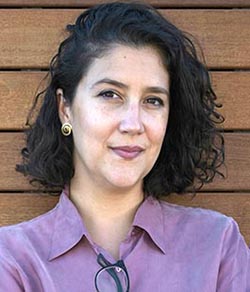Alvarez wins Rafael Hervada Award for spinal cord injury research
"Hopefully we can continue the work we published and generate new discoveries to help treat paralysis in patients."

Zaida Alvarez,
SQI Visiting Scholar
SQI visiting scholar Zaida Alvarez has received the Rafael Hervada Award for Biomedical Research in recognition of her recent first-author paper in Science describing an injectable therapy that reversed paralysis in mice following severe spinal cord injuries.
The Hervada Award honors innovation in scientific and medical research, and is considered one of the top prizes awarded in Spain for biomedical research.
Alvarez performed the work while she was a postdoctoral fellow and later a Research Assistant Professor in the laboratory of SQI director Samuel Stupp, who was the corresponding author of the paper. Alvarez is now a Ramon y Cajal Researcher at the Institute for Bioengineering of Catalonia in Barcelona (IBEC).
The key innovation in the winning research was the ability to harness the supramolecular motion of molecules within peptide amphiphile (PA) nanofibers to increase the efficacy of the therapy. The researchers discovered that molecules with enhanced motion — which have been nicknamed ‘dancing molecules’ — facilitated greater tissue repair and functional recovery in mice that had experienced paralyzing spinal cord injuries. Within four weeks of receiving a single injection, the mice regained the ability to walk.
In the Q&A below, Alvarez discussed the significance of the Hervada Award as well as the reaction the study received following its publication in November.
What does winning this award mean to you? Does it further emphasize the importance and quality of this work?
The Rafael Hervada Award provides great recognition in my own country. It is a national and international benchmark in the field of medical research, so I am honored that they chose my work over others with an incredible impact in biomedical engineering.
The president of the San Rafael Hospital highlighted the high quality of the work. She said it was one of the most brilliant works that have competed for the award, which makes me really proud and thankful about the type of research I was able to conduct at SQI during the last six years.
What was the most exciting aspect of the research and what are you most proud of?
The most exciting part of the project was to find a link between supramolecular motion and bioactivity. That was the first time we saw the effect of supramolecular motion on cell behavior. At the beginning, we were not 100 percent certain of the correlation, as we were just testing two or three materials. But then we designed a library of PAs with different mobilities and tested them in vitro to corroborate what we were seeing. When we analyzed the data and confirmed the correlation, we were really excited and knew this could be a great discovery.
What do you think about the response generated from this work, for example the coverage by hundreds of media outlets and the emails from so many patients and members of the public? Were you expecting this much feedback from the research, or was this a complete surprise?
I remember having this conversation with Professor Stupp before the publication because it was my first time publishing in Science magazine and I was not sure what to expect. He told me that the paper would have great impact in the scientific community.
However, we never expected the response we got after November 11. Both of us were shocked and positively surprised about the feedback we have gotten from scientists and patients. We are thankful about the way the media covered the news because it traveled everywhere. Since the paper has been published, we have received thousands of emails from patients around the world in the U.S., South America, Europe, and Asia.
The other side of the story is that those patients asked to be part of the next clinical trials and begged us treat them as soon as possible. This is heartbreaking. You want to help them, but science needs time and we need to make sure we are following all the steps to provide a secure and efficient material to treat spinal cord injury. We replied one by one to all the emails and explained the new steps of the work and how we are going to proceed. All the patients really appreciate the work we have done, as well as the scientific community that congratulated us on the discovery.
What are the next steps for the research? Have you initiated any new studies yet?
My research at IBEC will seek to develop synthetic platforms to study the effect on neural cells in injury and disease of the spinal cord. I aim to identify differences between the extracellular environment of injured versus healthy or developing versus adult central nervous system tissues and exploit these mechanistic discoveries to develop novel therapies that target the local environment. In my new position, I am still collaborating with Professor Stupp, who joined IBEC as Severo Ochoa Distinguished Professor, on some projects related to spinal cord regeneration and supramolecular materials. Hopefully we can continue the work we published and generate new discoveries to help treat paralysis in patients.